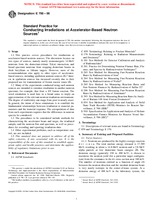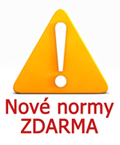Potřebujeme váš souhlas k využití jednotlivých dat, aby se vám mimo jiné mohly ukazovat informace týkající se vašich zájmů. Souhlas udělíte kliknutím na tlačítko „OK“.
ASTM E798-96
Standard Practice for Conducting Irradiations at Accelerator-Based Neutron Sources
Automaticky přeložený název:
Standardní praktiky pro dirigování ozáření při Accelerator na bázi neutronových zdrojů
NORMA vydána dne 1.1.1996
Informace o normě:
Označení normy: ASTM E798-96
Poznámka: NEPLATNÁ
Datum vydání normy: 1.1.1996
Kód zboží: NS-48026
Počet stran: 12
Přibližná hmotnost: 36 g (0.08 liber)
Země: Americká technická norma
Kategorie: Technické normy ASTM
Anotace textu normy ASTM E798-96 :
Keywords:
Accelerators, Beryllium-lithium targets, Cyclotrons, Irradiance/irradiation, Neutron flux/fluence, Neutron radiation, irradiations at accelerator-based neutron sources (on monoenergetic, 14-MeV neutrons from deuterium-tritium interactions/broad spectrum, neutrons from stopping deuterium beams in beryllium/lithium targets),, practice,, Deuterium-tritium interactions, Threshold detectors,em14 MeV, irradiations at accelerator-based neutron sources (of monoenergetic
Doplňující informace
| 1. Scope | ||||||||||||||||||||||
|
1.1 This practice covers procedures for irradiations at accelerator-based neutron sources. The discussion focuses on two types of sources, namely nearly monoenergetic 14-MeV neutrons from the deuterium-tritium T(d,n) interaction, and broad spectrum neutrons from stopping deuterium beams in thick beryllium or lithium targets. However, most of the recommendations also apply to other types of accelerator-based sources, including spallation neutron sources (1). Interest in spallation sources has increased recently due to their proposed use for transmutation of fission reactor waste (2). 1.2 Many of the experiments conducted using such neutron sources are intended to simulate irradiation in another neutron spectrum, for example, that from a DT fusion reaction. The word simulation is used here in a broad sense to imply an approximation of the relevant neutron irradiation environment. The degree of conformity can range from poor to nearly exact. In general, the intent of these simulations is to establish the fundamental relationships between irradiation or material parameters and the material response. The extrapolation of data from such experiments requires that the differences in neutron spectra be considered. 1.3 The procedures to be considered include methods for characterizing the accelerator beam and target, the irradiated sample, and the neutron flux and spectrum, as well as procedures for recording and reporting irradiation data. 1.4 Other experimental problems, such as temperature control, are not included. 1.5 This standard does not purport to address all of the safety concerns, if any, associated with its use. It is the responsibility of the user of this standard to establish appropriate safety and health practices and determine the applicability of regulatory limitations prior to use. |
||||||||||||||||||||||
| 2. Referenced Documents | ||||||||||||||||||||||
|
Odebírejte informace o nově vydaných normách ZDARMA:
Chcete pravidelně odebírat informace o nově vycházejících normách z celého světa a to zcela zdarma?
Přihlašte se k odběru. Vše je velice jednoduché a absolutně ZDARMA.
Na výběr máte vydavatele z celého světa.




 Cookies
Cookies
